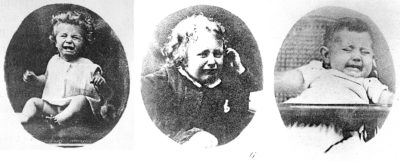The expression of emotions in man and animals is a book by the British naturalist Charles Darwin published in 1872, which discusses how human and other animals express their emotions.
It is one of Darwin’s most unknown books, although it was conceived as part of a trilogy, which would complete the path of The Origin of Species and The Origin of Man.
It was an atypical book for the time, which included photographic images to illustrate the manuscript. John Murray, the publisher of the book, warned that an edition that included up to seven heliotype plaques would be very expensive, and that “would cause a terrible hole to profits.” Although it did not reach the success of its two predecessors, the work turned out to be very popular and surpassed the 5,000 sold copies.
Darwin: a revolutionary thinking
Throughout the text, Darwin describes the main expressive actions in humans and other animals. From his analysis, he extracts a series of facial expressions that he catalogs as universals. He finds them associated with suffering, tenderness, fear or shame.

Once again, Darwin makes use of his rigor and his expertise to convince the scientific community – and the society of the time – of the veracity of the theory of evolution by natural selection, through the whole work. He fills the book of examples, leaving no room for doubt and reinforcing, chapter after chapter, the idea that all animals share a common origin.
The expression of emotions [from the original title The expression of emotions in man and in animals] is a brave book for the time it was published, but no less prudent than the rest of Darwin’s production. “Darwin’s theory of evolution broke with the paradigm established at the time by the church and institutions. Charles, who was aware of the discomfort aroused by his claims, and of the great scrutiny that all that he defended was subjected to, was always very prudent”, says Xavier Bellés, principal investigator of the Institute for Evolutionary Biology (IBE: CSIC-UPF) and the translator of the original text to Catalan.
“Darwin’s theory of evolution broke with the paradigm established at the time by the church and institutions. Charles, who was aware (…) was always very prudent”
Xavier Bellés
This book differs from The origin of the species and The origin of man in which it allows us to see Darwin not only as a scientist, but as a man. Throughout the work, he analyzes in great detail the behavior of his own family and companion animals, revealing between lines his private life. “The expression of emotions is like a window to the more personal Charles Darwin, who we can get a glimpse of beyond the scientist’s speech”, says Bellés.

Credit: Wellcome Library, London. Wellcome Images. Copyrighted work available under Creative Commons Attribution only licence CC BY 4.0
The history of the research of universal emotions
It must be said that this interest in classifying emotions was not new in history. Before Darwin, the artist Charles le Brun (painter of Louis XIV) dared to try to reproduce “passions” through painting. He did it in his treatise, published posthumously, and called Méthode pour apprendre à dessiner les passions (1698).
Darwin’s The expression of the emotions represents, however, the first step in the observation of emotions using the scientific method, being a precursor to the modern disciplines of ethology and psychology.
With the translation and introduction of Xavier Bellés
The expression of the emotions is a volume of the «Clásicos de la Ciencia» (“Classics of Science”) collection, a joint initiative of the Section of Biological Sciences and the Section of Science and Technology of the Institut d’Estudis Catalans (Institute of Catalan Studies). The principal investigator of the IBE (CSIC-UPF), Xavier Bellés, was responsible for translating the original text into Catalan, as well as writing the introduction. This collection is a work tool for studying the history of science, which also aims to be a bridge that approaches the worlds of sciences and humanities.







